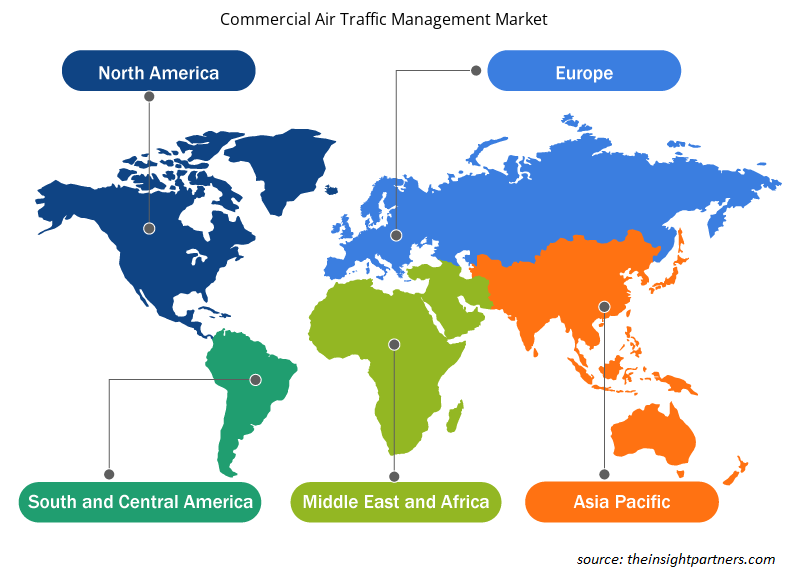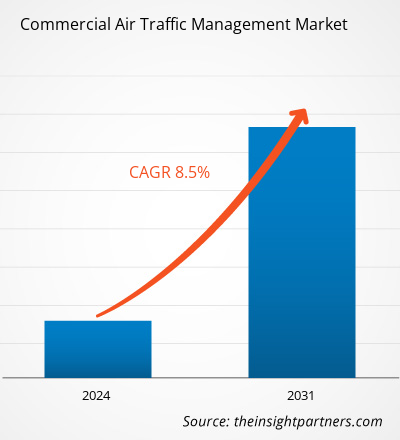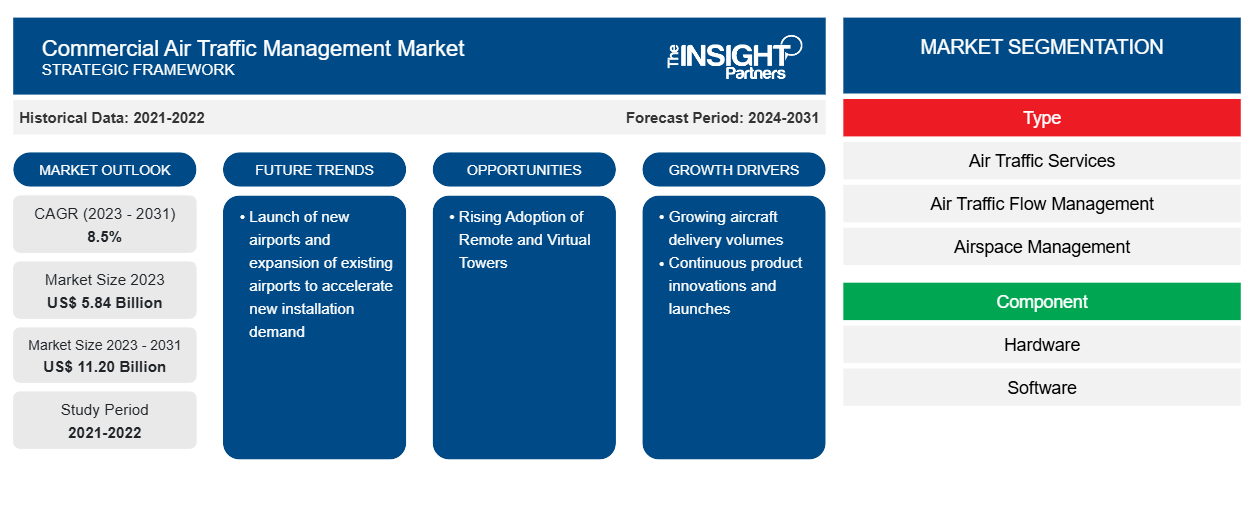상업용 항공 교통 관리 시장 규모는 2023년 58억 4천만 달러에서 2031년까지 112억 달러에 도달할 것으로 예상됩니다. 이 시장은 2023~2031년 동안 8.5%의 CAGR을 기록할 것으로 예상됩니다. 새로운 공항을 개설하고 기존 공항을 확장하여 새로운 설치 수요를 가속화하는 것은 시장의 주요 추세로 남을 가능성이 높습니다.
상업용 항공 교통 관리 시장 분석
상업용 항공 교통 관리 시장의 구매자에는 효율적이고 안전한 항공 운영을 위한 고급 항공 교통 관리(ATM) 솔루션 조달에 점점 더 투자하고 있는 상업용 공항과 그 당국이 포함됩니다. 현재 공항 건설 프로젝트가 진행 중이어서 구매자의 구매력이 적당합니다. 그러나 공항 건설이 끝나갈 무렵에는 ATM 솔루션에 대한 수요가 증가하여 구매자의 협상력이 높아질 것입니다. 또한 상업용 ATM 시스템의 수명이 길어 현재 구매자의 협상력이 낮습니다. 그러나 공항 전체에 걸쳐 새로운 ATM 시스템을 업데이트하는 동안, 특히 기존 시스템은 향후 몇 년 동안 구매자의 협상력을 높일 것으로 예상됩니다.
상업용 항공 교통 관리 시장 개요
글로벌 상업용 항공 교통 관리 시장 생태계의 주요 이해 관계자로는 구성 요소 제조업체, 하드웨어 제조업체, 소프트웨어 공급업체, 정부 기관 및 최종 사용자가 있습니다. 글로벌 상업용 항공 교통 관리 시장에서 운영되는 구성 요소 제조업체는 송신기, 안테나, 수신기, 표시기, 배터리, 조명, 센서 및 기타 장비를 제공합니다. 이러한 모든 구성 요소의 적시 공급은 항공 교통 관리 시스템 제조 공장에서 효율적인 운영에 매우 중요합니다. 이러한 구성 요소 공급업체에 운영상 영향이 있으면 항공 교통 관리 시스템 생산이 지연되어 상업용 항공 교통 관리 시장에 직접적인 영향을 미칩니다.
귀하의 요구 사항에 맞게 이 보고서를 사용자 정의하세요
이 보고서의 일부 또는 국가 수준 분석, Excel 데이터 팩을 포함하여 모든 보고서에 대한 사용자 정의를 무료로 받을 수 있으며 신생 기업 및 대학을 위한 훌륭한 혜택과 할인 혜택을 이용할 수 있습니다.
-
이 보고서의 주요 시장 동향을 알아보세요.이 무료 샘플에는 시장 동향부터 추정 및 예측까지 다양한 데이터 분석이 포함됩니다.
상업용 항공 교통 관리 시장 동인 및 기회
지속적인 제품 혁신 및 출시
글로벌 항공 산업은 새롭고 혁신적인 제품 측면에서 변화하고 있습니다. 산업 분야 전반의 이해 관계자들은 산업 운영을 단순화하기 위한 견고한 솔루션을 혁신하고 개발하기 위해 지속적으로 R&D에 투자하고 있습니다. 항공 교통 관리 시스템에 대한 수요가 증가함에 따라 최근 몇 년 동안 시장 참여자들은 새롭고 혁신적인 제품 개발에 투자해야 했습니다. 주요 제품 개발 중 몇 가지는 다음과 같습니다.
- 2022년 7월, EUROCONTROL은 업데이트된 항공 교통 관리 감시 추적기 및 서버(ARTAS)를 출시했습니다. 새 버전(V 9.0.2)에는 여러 가지 새로운 커뮤니티 소스 기능이 있으며, 해당 문제가 해결될 것으로 보고되었습니다.
- 2022년 6월, Indra Sistemas SA와 Eurocontrol Maastricht Upper Area Control Centre(MUAC)는 항공 교통 관제 시스템이 항공 교통을 정확하게 관리할 수 있도록 하는 항공 통신망(ATN)과 자동 종속 감시 계약 시스템(ADS-C)의 배치를 발표했습니다.
- Thales SA는 2022년 6월, 공항의 보안을 강화하고 승객에게 원활한 여행 편의를 제공하기 위해 X선 나노기술 기반 전자 스캐닝과 3D 영상 재구성을 결합한 C3 규격 스캐너인 HELIXVIEW 출시를 발표했습니다.
이러한 발전으로 인해 전 세계적으로 상업용 항공 교통 관리 시장이 성장하고 있습니다.
원격 및 가상 타워 채택 증가
원격 및 가상 타워는 원격으로 항공 교통 운영을 규제하고 유지하는 데 도움이 됩니다. 전 세계 여러 공항에서 이러한 타워를 채택하여 공항 운영을 보다 빠르고 안전하게 만들었습니다. 2022년 6월, 브린디시 공항은 이탈리아에서 최초로 원격으로 관리되는 관제탑을 개장했습니다. 새로운 원격 디지털 타워는 항공 교통 관제사가 원격 타워 모듈에서 이륙, 착륙 및 지상 운영을 관리하는 데 도움이 됩니다. 이 모듈은 또한 항공 교통 관리를 지원하고 공항의 안전성과 운영 효율성을 향상시킵니다. 2022년 5월, 북부 독일의 브라운슈바이크-볼프스부르크와 엠덴 공항이 DFS Aviation Services GmbH(DAS)와 Frequentis에 이 지역에 원격 타워 센터를 건설하도록 의뢰했으며, 이 센터는 2024년 중반에 운영을 시작할 예정입니다. 따라서 효율적인 항공 교통 관리를 위한 원격 및 가상 타워의 채택과 투자가 증가함에 따라 상업용 항공 교통 관리 시장의 성장이 촉진될 것으로 예상됩니다.
상업용 항공 교통 관리 시장 보고서 세분화 분석
상업용 항공 교통 관리 시장 분석에서 도출된 주요 세그먼트는 유형, 구성 요소, 응용 프로그램 및 공항 등급입니다.
- 유형에 따라 상업용 항공 교통 관리 시장은 항공 교통 서비스, 항공 교통 흐름 관리, 공역 관리 로 세분화됩니다 . 공역 관리 부문은 2023년에 더 큰 시장 점유율을 차지했습니다.
- 구성 요소를 기준으로 상업용 항공 교통 관리 시장은 하드웨어와 소프트웨어로 구분됩니다. 하드웨어 세그먼트는 2023년에 더 큰 시장 점유율을 차지했습니다. 하드웨어 세그먼트는 레이더, 안테나, 디스플레이 시스템 등으로 더 세분화됩니다.
- 응용 프로그램을 기준으로 상업용 항공 교통 관리 시장은 통신, 항법, 감시, 교통 통제 및 기타로 세분화됩니다. 감시 부문은 2023년에 더 큰 시장 점유율을 차지했습니다. 항법 부문은 CVOR, DVOR, DME, ILS, DF 및 NDB로 더 세분화됩니다. 감시 부문은 PSR, SSR 및 MLAT로 더 세분화됩니다.
- 공항 등급에 따라 상업용 항공 교통 관리 시장은 Class I, Class II, Class III, Class IV로 세분화됩니다. Class I 세그먼트는 2023년에 더 큰 시장 점유율을 차지했습니다.
지리적 지역별 상업용 항공 교통 관리 시장 점유율 분석
상업용 항공 교통 관리 시장 보고서의 지리적 범위는 주로 북미, 유럽, 아시아 태평양, 중동 및 아프리카, 남미의 5개 지역으로 나뉩니다.
북미는 2023년 시장을 지배했고 그 뒤를 유럽과 아시아 태평양 지역이 따랐습니다. 나아가 아시아 태평양은 향후 몇 년 동안 가장 높은 CAGR과 함께 북미 시장을 앞지를 가능성이 높습니다. 미국은 2023년 북미 상업용 항공 교통 관리 시장을 지배했습니다. 이는 주로 다음 때문입니다. 미국 항공 산업은 글로벌 항공 부문의 주요 국가 중 하나입니다. 이 나라는 매년 수백만 명의 승객을 태워주는 가장 많은 수의 항공기 함대를 보유하고 있습니다. 예를 들어, 미국 항공사는 2023년에 8억 6,200만 명이 넘는 승객을 태웠습니다. 승객 교통량의 증가로 인해 미국 항공사 전체에서 더 많은 수의 항공기 함대를 조달하고 ATM 운영에 대한 요구 사항이 더 커지고 있습니다. 게다가, 미국 내 여러 공항의 기존 ATC 타워를 업그레이드하고 미국 내 여러 공항의 새로운 ATC 타워를 시운전하면서 전국의 상업용 항공 교통 관리 시장 성장이 촉진되고 있습니다. 전국의 여러 공항은 새로운 터미널, ATC 타워 건설, 공항 전체의 다른 부문 업그레이드를 포함하는 다양한 확장 프로세스를 거쳤습니다. 예를 들어, 2022년 8월, 피닉스-메사 게이트웨이 공항은 애리조나 공항 전역에서 증가하는 항공 교통을 처리하기 위해 ATC 타워를 상용화했습니다. 마찬가지로, 연방 항공청(FAA)은 미국 영공의 변화를 위해 항공 교통 관리 시스템을 업그레이드하여 안전, 효율성 및 환경적 책임을 강화하기 위한 여러 공항 계획을 시행하고 있습니다. 이러한 요인은 북미 지역에서 미국 상업용 항공 교통 관리 시장의 성장을 촉진해 왔습니다.
상업용 항공 교통 관리 시장 지역 통찰력
Insight Partners의 분석가들은 예측 기간 동안 상업용 항공 교통 관리 시장에 영향을 미치는 지역적 추세와 요인을 철저히 설명했습니다. 이 섹션에서는 북미, 유럽, 아시아 태평양, 중동 및 아프리카, 남미 및 중미의 상업용 항공 교통 관리 시장 세그먼트와 지리에 대해서도 설명합니다.

- 상업용 항공 교통 관리 시장을 위한 지역별 특정 데이터 얻기
상업용 항공 교통 관리 시장 보고서 범위
| 보고서 속성 | 세부 |
|---|---|
| 2023년 시장 규모 | 58억 4천만 달러 |
| 2031년까지 시장 규모 | 112억 달러 |
| 글로벌 CAGR (2023-2031) | 8.5% |
| 역사적 데이터 | 2021-2022 |
| 예측 기간 | 2024-2031 |
| 다루는 세그먼트 |
유형별로
|
| 포함된 지역 및 국가 |
북아메리카
|
| 시장 선도 기업 및 주요 회사 프로필 |
|
시장 참여자 밀도: 비즈니스 역학에 미치는 영향 이해
상업용 항공 교통 관리 시장은 소비자 선호도의 변화, 기술 발전, 제품의 이점에 대한 인식 증가와 같은 요인으로 인해 최종 사용자 수요가 증가함에 따라 빠르게 성장하고 있습니다. 수요가 증가함에 따라 기업은 제품을 확장하고, 소비자의 요구를 충족하기 위해 혁신하고, 새로운 트렌드를 활용하여 시장 성장을 더욱 촉진하고 있습니다.
시장 참여자 밀도는 특정 시장이나 산업 내에서 운영되는 회사나 기업의 분포를 말합니다. 주어진 시장 공간에 얼마나 많은 경쟁자(시장 참여자)가 존재하는지 그 규모나 총 시장 가치에 비해 나타냅니다.
상업용 항공 교통 관리 시장에서 운영되는 주요 회사는 다음과 같습니다.
- 탈레스 SA
- BAE 시스템 주식회사
- 인드라 시스테마스 SA
- L3해리스 테크놀로지 주식회사
- 레이시온 테크놀로지스 코퍼레이션
- 허니웰 인터내셔널 주식회사
면책 조항 : 위에 나열된 회사는 어떤 특별한 순서에 따라 순위가 매겨지지 않았습니다.

- 상업용 항공 교통 관리 시장의 주요 주요 업체 개요를 알아보세요
상업용 항공 교통 관리 시장 뉴스 및 최근 개발
상업용 항공 교통 관리 시장은 1차 및 2차 조사 이후의 정성적, 정량적 데이터를 수집하여 평가합니다. 여기에는 중요한 기업 간행물, 협회 데이터 및 데이터베이스가 포함됩니다. 상업용 항공 교통 관리 시장의 몇 가지 개발 사항은 다음과 같습니다.
- Thales는 2014년 Zambia Airports Corporation Limited(ZACL)와 체결한 계약에 따라 잠비아의 루사카와 리빙스턴 국제공항에 있는 ATC(항공 교통 관제) 센터를 현대화하고 있습니다. (출처: Thales, 보도 자료, 2023년 10월)
- EUROCONTROL MUAC과 Indra는 비행 중인 항공기와의 자동 데이터 교환을 위한 혁신적인 ATN 자동 종속 감시 계약 시스템(ADS-C)을 구현하여 교통 관리의 정확도를 높였습니다. 이는 예측 가능성을 높이고, 조기 충돌 감지를 용이하게 하며, 궤적 기반 운영(TBO)을 향한 첫 번째 단계가 될 것입니다. 또한 항공기 상승 및 하강을 최적화하여 더 오랫동안 최적의 비행 수준을 유지하고 연료 소비를 최소화합니다(출처: Indra, 보도 자료, 2022년 6월)
상업용 항공 교통 관리 시장 보고서 범위 및 제공물
"상업용 항공 교통 관리 시장 규모 및 예측(2021-2031)" 보고서는 아래 영역을 포괄하는 시장에 대한 자세한 분석을 제공합니다.
- 범위에 포함된 모든 주요 시장 세그먼트에 대한 글로벌, 지역 및 국가 수준의 상업용 항공 교통 관리 시장 규모 및 예측
- 상업용 항공 교통 관리 시장 동향 및 운전자, 제한 장치 및 주요 기회와 같은 시장 역학
- 포터의 5가지 힘에 대한 자세한 분석
- 주요 시장 동향, 글로벌 및 지역 프레임워크, 주요 참여자, 규정 및 최근 시장 개발 사항을 포괄하는 상업용 항공 교통 관리 시장 분석
- 시장 집중도, 히트맵 분석, 유명 업체 및 상업용 항공 교통 관리 시장의 최근 개발 사항을 다루는 산업 환경 및 경쟁 분석
- 자세한 회사 프로필
- 과거 분석(2년), 기준 연도, CAGR을 포함한 예측(7년)
- PEST 및 SWOT 분석
- 시장 규모 가치/거래량 - 글로벌, 지역, 국가
- 산업 및 경쟁 환경
- Excel 데이터세트
최근 보고서
관련 보고서
사용 후기
구매 이유
- 정보에 기반한 의사 결정
- 시장 역학 이해
- 경쟁 분석
- 고객 인사이트
- 시장 예측
- 위험 완화
- 전략 기획
- 투자 타당성 분석
- 신흥 시장 파악
- 마케팅 전략 강화
- 운영 효율성 향상
- 규제 동향에 발맞춰 대응























 무료 샘플 받기 - 상업용 항공 교통 관리 시장
무료 샘플 받기 - 상업용 항공 교통 관리 시장